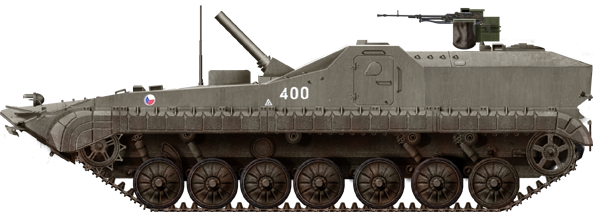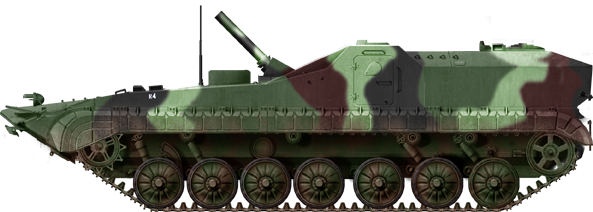Genesis and Development

Závody ťažkého strojárstva Dubnica nad Váhom, produced this rare vehicle in 1985-90. AFV buffs would immediately see a filiation with the BMP-1 produced under licence as the BVP-1 in Czechoslovakia during the cold war. The BVP-1 was the object of multiple variants but the PRAM-S was probably the most extreme. Today, as per NATO regulation for both successors state, the vehicle is known as the SPM-85 PRAM. Only twelve were ever made just after two prototypes in 1982-83.
Czechoslovakia during the cold war modified a number of vehicles as mortar carriers in part those of soviet origin. One of the most advanced, dedicated of such vehicles was based on the BMP-1. When ready for production the situation changed dramatically. The collapse of the soviet union and dislocation of the former warsaw pact put former projects in disarray. The bulk of these most advanced projects were distributed to both successors state. In the case of the ShM vz.85 (Pram-S) developed at ZTS in 1981-85 at the time in Czechoslovakia and submitted to Soviet approbation.
The PRAM-S was essentially a self-loaded mortar system (SPM-85 PRAM) mounted on an elongated BVP chassis, to provide permanent fire support for a mechanised battalion and target anti-tank assets, personal and lightly armoured targets or field shelters. Its early development followed the specifications above and the chassis chosen was that of the ageing BMP-1 rather than the more precious BMP-2 also built locally. In 1982, ZTS completed the first prototype for this 120 mm mortar carrier. In 1983 the second (or 1982 as well) was tested, and these field tests went on until 1985 when production was approved. It went on from 1986 to 1990, terminated after the 12th vehicle.
By early 1992, ZTS announced the PRAM-S's production complete and deployment in four batteries of six systems to be effective. But with the break-up of Czechoslovakia, production and marketing was concentrated in the hand of ZTS in the Slovak Republic. Of the 12 built, six went into service with the Czech Republic (which co-financed the project back in 1990) and the remainder with the Slovak Republic, making for a single battery for each country.
Production was shut down by the PRAM-S was still offered on the export market by ZTS in the 2000s and seemingly stll today. No exports were made so far however. The mortar system integration is judged modular enough to be ported on more recent BMP-2 chassis or western vehicles. Wheeled vehicles were also considered as reported by late 2001, as well as new enhancements but by 2007 nothing came out of it. The twelve vehicles are seemingly still active.
Detailed Design
Hull layout and protection
The PRAM-S 120 mm is based on a modified BMP-1 infantry fighting vehicle chassis (and not a BMP-2 as seen oin other sources). Its turret was removed, the fighting compartment spaced out, the roof raised in order to accept a 120 mm mortar system which could offer full armour protection to its crew. The lengthened chassis is raised at the rear and gained an extra axle, for seven road wheels of the exact same model as the others, with torsion bars and stamped metal wheels. The drive sprocket remains at the front, idler at the rear, four track-return rollers. Hydraulic shock-absorbers are still the same, fitted on the first two and last two road wheel stations. Due to the extra axle, damping is a bit more effective, compounded by the vehicle's overall higher weight ratio.Like in the original BVP-1, the driver is seated at the front left, engine compartment at the right, and the raised rear space was calculated to accomodate both the 120 mm mortar and its ammunition in cradled as well as the crew. The latter could stand inside and served the mortar from a kneeled position. There are two seats on the left side, one of the left, the remaining being occupied by the driver forward. The forward part of the roofed casemate allows the 120 mm breech-loaded mortar tube to be permantely out, which a railing enabling 15° left and right traverse while elevations goes from +40 to +80°, all manual.
The commander is seated to the right of the mortar, provided with a roof hatch and three day periscopes as well as an infra-red searchlight. The gunner is located opposite to the commander with his own roof day laying system and using his side's forward-opening door provided a vision block. The commander is tasked to received instruction from the fire control center via a R-123 UHF/VHF radio which antenna is located forward and to the left of the driver's hatch. Rear of the commander is a roof hatch and 12.7 mm NVS machine gun used for anti-aircraft or close defence. The loader was seated towards the mortar's rear; responsible for preparing the bombs, setting the charges and load them into the automatic loader from ammunition bins on the left and right rear.
As for protection, the PRAM-S is protected the same way the older BVP-1 was provided with RHA steel, 14.5 mm proof glacis (more thanks to the sloped angle) and sloped sides and rear providing protection against small arms fire and shrapnel. There is also a collective NBC system with full sealing and overpressure. Two automatioc detectors.fire extinguishers using Halon are placed on the engine and fighting compartment. The vehicle lacked smoke projectors but could still lay its own smoke screen thanks to fiel external injectors of the exhaust outlet on the right side which had a cowl-type shroud.
Engine and Performances
The PRAM-S is powered by an UTD-20 four-stroke, V6 (120°) liquid cooled diesel located forward in the nose. It could develop a maximum torque of 723 (+36/-72) lb.ft. This unit weighted 1466 lb and was 31,1 inches long including the protruding shaft, 45,3 inches wide and 28,8 inches high. It had a compression ratio of 15,8 and capacity of 970 cubic inches and developed and output of 295 bhp at 2600 rpm. It was coupled to a mechanical synchromesh gearbox 5+1 with main clutch and planetary cross-drive transmission weighting 1182 lb.This allowed the vehicle to rezach 39 mph in top speed, 17-21 mph cross country for a range of 342 miles. It could negociate a gradient of 78%, a side slope of 56%, gap a 98 inches (2.5 m) trench, and climb a 28 inches (70 cm) vertical obstacle. It was amphibious due to enough buoyancy at least on paper. It is conformed by the official page and other sources, including with its full 60 bombs load.
Mortar
The 120 mm PRAM mortar (6 ft 3.5 inches or 2.8m long) is capable of a range between 500 and 8,000 m at 80° elevation, and that depends on the ammunition and their propelling charge. Foir a well drilled crew, the rate of fire could be up to 18-20 rds/min, or 40 rounds in 5 minutes and 70 rounds in 10 minutes, basicaly all the bomb load. Placed on a slopes up to 5° or transverse slopes up to 5° the vehicle is still capable of operating normally. It could fire the 120 OFd bomb at 8,788 yd or the 53-OF-843B bomb at 7,765 yd.It should however halt before firing. Preparation from there is a 1 minute and another is necessary after firing to depart and avoid counter-battery fire. In travel position the 120 mm mortar is at minimum elevation below the armoured covers, which are unfolded either side for higher combat elevation. The bombs are stowed vertically, head down, tail up. The loading system uses a chain and rammer loading these into the mortar. On the 80 rounds carried 21 are ready rounds already in the conveyor, 59 rounds in the magazines. This allows to fire a burst over a minute and move out to reload the conveyor.
Other Armament
On the Czech Republic website's page on the Self-propelled 120 mm Mortar PRAM S, the vehicle could fire via the mortar the anti-tank 9K113 Konkurz (SPANDREL) guided missile system, and if defended up close by a cupola ring mounted NSV 12.7 mm heavy machine gun located aft of the mortar compartment. The crew of four caries their own personal weapons but also portable anti-tank RPG-75 grenade launchers, defence hand grenades F1 and submachine guns 7.62 mm type 58.specifications | |
| Dimensions (L-w-h) | 7,470 x 2,940 x 2,250 mm |
| Total weight, battle ready | 15,970 kgs |
| Crew | 4 (driver, cdr, gunner, loader) |
| Propulsion | UTD-20 V6 diesel 295 bhp |
| Speed (land/water) | 63 kph and 10 kph |
| Range (on flat) | 550 km |
| Armament | 120 mm mortar (80 rds), 12,7 mm SVT-1 HMG |
| Armor | As BVP-1 |
| Total production | 12+2 |
Illustrations

Basic Czech service vehicle in 1992 livery and markings, 72th mechanized battalion.

4th vehicle, working with the military Technical and Test Institute of Zahorie in 2007
Gallery

Vehicle 403 from the 72th mechanized battalion

PRAM-S as presented in 1985

PRAM-S in parade, Prague

V.Bourguignon depiction of the Czech training vehicle
Related links
Armoured Vehicles 1944-2001 and their Production in the Slovak Republic; Magnet Press Slovakia 2002;army-guide.com
acr.mo.gov.cz
armedconflicts.com
idnes.cz/
vhu.sk
technika.specwar.info
On free3d.com
cs.wikipedia.org/
Nice closeup on Flickr

Modern Tanks
Modern MBTs posters

Denel Bagder (2018)

Type 16 MCV (2016)

Gepard 1A2 last rounds 2011

SANDF

Russian AFVs

Main Battle Tanks

